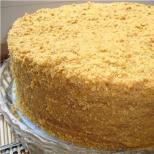Ordinary almonds: medicinal plant. Almond ordinary, medicinal properties, description, application, contraindications, prescriptions, photos.
A small tree is 2-6 (8) m high. Shoots are bare, reddish-brown; the cortex of branches is gray-brown, old trunks - almost black. Stipules are subulate, small, early falling down. Leaves alternate, on shortened branchlets, arranged in bundles, petiolate, 4-6 (9) cm long, glabrous, lanceolate or narrow elliptical, with long-pointed, less often blunt apex and broad-wedged base; the margin of the leaf is obtuse-serrate-toothed. Petioles 1-3 cm in length. Flowers that blossom before leaves, solitary, develop on last year's shoots; pedicels 3-5 mm in length. Hypantium cylindrical, with five broadly lanceolate, obtuse, along the edge of long-haired segments of calyx, reaching 4-5 mm in length; corolla five-leaved; the petals are wedge-shaped, more or less prominent at the apex, white or light pink, 1.5-2 cm long. Stamens are numerous; pestle with upper, sessile at the bottom of the hypanthium, with a pinnate-haired ovary, with a thin and long stalk (especially in A. communis L. f. dulcis DC.) with a column and a stigma on one side. Fruits - 3 to 5 cm long (4) cm long, obliquely or oblong-ovate, compressed, apically dentate or obtuse, unequal, on one side with deep groove, greenish or brownish gray, with velvety pubescence. The pericarp is rather dry, leathery, about 2 mm thick. Bone is about 3 cm in length, from whitish to brown in color, with firm or rather brittle, from the surface of a hole-pitted or deep-shelled shell. Seeds without endosperm, with yellowish-brown rough skin, ovate-elongated, flattened, apically pointed at the apex, about 2 cm in length, bitter (A. communis L. f. Amara DC.) Or sweet (A. communis L. f. Dulcis DC). There are 1000 "seeds" (bones) around 1188. It blooms in February-April; fruits ripen in June - July.Location. It grows wild in Kopet-Dag, Western Tien-Shan, and also in the south of Azerbaijan (Karabakh). It grows on the southern stony or gravelly slopes of the mountains, rising to 800-1,600 m above sea level; sometimes forms significant thickets. Successfully cultivated in Central Asia, eastern Transcaucasia and the Crimea.
Used part. Seeds of bitter and sweet almonds.
Chemical composition. Seeds contain 45-62% of fatty oil (obtained by cold pressing); the composition of the oil includes glycerides of oleic (83%) and linoleic (16%) acids and unsaponifiable substances (up to 0.5%). In addition to oil, the seeds contain: glucoside amygdalin C20H27O11N (3-4%); hematin OH; vitamin B2; up to 20% of proteinaceous substances and 2-3% of sucrose.
Application of almonds
The emulsion from the seeds of sweet almonds and bitter-mixed water from the seeds of bitter almonds are used for pain in the stomach and intestines. Almond oil is used inside as a gentle laxative, externally - to soften the skin. Seed cake (almond bran) is used for cosmetic purposes as a means to soften and purify the skin of the face. In pharmaceutical practice, almond oil is used as the basis of liquid ointments and emulsifier. Seeds of bitter almonds are poisonous. Toxicity is due to the presence in them of glucoside amygdalin. When poisoning is observed salivation, nausea, vomiting , headache , shortness of breath, slowing of the pulse, dilated pupils, general weakness, convulsions, in severe cases - stopping breathing with a fatal outcome.Preparations: emulsion, almond oil, bitter water.
Plant almond - a small tree or shrub of the subgenus Almond of the genus Plum family Pink. It is often considered to be nuts, although in fact it is a stone fruit. Almond grew in the Mediterranean and Central Asia for many centuries before our era. Today it is also distributed in China, California, Slovakia, the Czech Republic and South Moravia. This light-loving and drought-resistant culture grows in nature in small groups of several trees or shrubs at an altitude of 800 to 1600 m above sea level. In our country, ordinary almonds are usually found in the southern zone of the European part. In the middle belt, almonds are grown in steppe, or a beaver, or almonds are low, or a shallow plum. The value of this kind of almonds is not only in the kernels of its fruits, but also in the high ornamentality of its leaves and flowers. A three-lobed almond is one of the most beautiful garden shrubs, which is grown solely for the sake of its decorative qualities. We wrote about how the planting and caring for almonds is ordinary, in the article "Almonds - planting and care, pruning and grafting". Today we will tell you how to plant and care for ornamental shrubs almonds.
Listen to the article
Decorative almonds - description
The ornamental shrub almonds are usually medium in size (2.5-3 m), it is easy to grow it even by inexperienced horticulturists. It is one of the most valuable ornamental crops. Some varieties of ornamental almonds are grown on a stem, and then the bush looks like almond tree with dark green lanceolate leathery leaves with a serrate edge, creating together with the branches a spherical compact crown. Blossoms decorative almonds, usually for the fourth or fifth year after planting: incredible beauty flowers with a lot of petals and stamens, simple or terry, pink or white - they envelop the shrub almonds with an air cloud sometimes up to 3 weeks. Anyone who has ever seen flowering almond branches will never forget this magic. The leaves of the almond blossom usually after flowering. The fruit of the decorative almond is inedible, but also decorative: rounded suede three-lobed pericarp, in which there is an easily separable bone.
Almond is a close relative of such fruit trees as plum , cherry , bird cherry, apricot , plum , peach , nectarine , turn and sakura. He also has relatives pear , apple tree , quince , dog rose, rose flower , hawthorn, aronia and mountain ash.
The decorative almond is unpretentious, resistant to drought, it is a valuable honey and, with good care, can live more than a hundred years. Decorative types of almonds, unlike ordinary almonds, grown mainly for the sake of its fruits, are able to withstand the severe winters of the middle belt, and almonds in Siberia, too, have ceased to be wonders.
Planting almonds
When to plant almonds.
Planting of ornamental almonds is carried out in the fall, after the fall of the fall, and in the spring, after the establishment of warm days, so that recurrent frost does not coincide with the beginning of vegetation of the plant. However, the autumn planting of almonds is preferable.
How does almonds grow? What kind of soil does he prefer? There will be no almonds to grow in acidic or saline soils - the pH should be in the range of 4.5-7.5, and the occurrence of groundwater on the site should be deep. The best grows almonds in light, fertile loamy or sandy loamy soil, but heavy clay soils will ruin it. Since decorative almonds like air and sun, allocate for him a place in the southern part of the garden. This may be a site that is under the sun all day, or a place where an almond tree will be 2-3 hours a day to fall shadow from a growing number of trees.

How to plant almonds.
Since almonds require cross-pollination, it is advisable to plant several almond bushes at the same time. Pollination of almonds mainly bees, and the proximity to the site of the apiary with several hives would be very handy.
Clear the area under the planting from the plants that give a shadow, and the stones can not be removed - almonds in nature grows mainly on stony slopes. Excavate pits with a depth of at least 30 cm at a distance of 3-5 m from each other in a row, keeping a distance of about 5 m between rows. At the bottom of each pit, fill a layer of broken brick or crushed stone for drainage, lay a layer of sand on top and drive a long a pole for the support of the seedlings - the support should rise above the surface of the site by at least half a meter.
Planting shrub almonds is carried out in the early morning or after 16 o'clock in the afternoon. Annual almond seedlings are rooted in a clay bolt before planting, then placed in pits so that the root neck is several centimeters above the surface of the site, and the pit is filled with a mixture of topsoil with leafy soil, humus and sand. If the soil is in the area of acid reaction, add a little lime or dolomite flour to the soil mixture. After planting, compact the soil around the seedling and pour under it one and a half buckets of water. When the water is absorbed and the soil settles slightly, tie the seedling to the support and cover the root canal with dry soil or peat so that the mulch does not touch the root neck, which should be at the level of the surface after irrigation.
Shrub almonds - care
How to grow almonds? Planting and caring for ornamental almonds are not difficult. How to plant almonds you already know, and caring for almonds is carried out in the same way as for any other decorative tree or shrub: irrigation, loosening, weeding, feeding, pruning, processing from insects and pests.

Watering is carried out, not permitting the drying of the soil in the near-barrel circle, however, overmoistening of the soil threatens to decay the root neck of the plant. It is enough to pour a bucket of water once a week under a tree or a bush of almonds, if the soil is dried to a depth of 1.5-2 cm. After watering, it is convenient to loosen the soil to a depth of 5-7 cm around the young plants and 8-10 cm around the mature ones. Keep clean in the trunk, remove the weed grass as soon as it appears.
Planting and caring for bush almonds involves introducing additional dressings. In the spring, it is possible to swallow the near-trunk circle not with peat but with manure or mullein, and a little later each bush is fed with 10 grams of urea and 20 grams of ammonium nitrate, diluted in a bucket of water. In autumn, 20 g of potassium sulfate and double superphosphate are applied to each m² of the plot.
Pruning almonds.
Almonds in the garden need pruning. In the spring, before the sap move, sanitary pruning of bushes is carried out, removing broken, frostbitten, diseased, dry shoots and twigs thickening the crown. Sometimes one branch of an almond prevents to grow another - they are called competing. Leave to grow that branch, which is located more successfully, and the other is cut out. Formative pruning is carried out when the almond bloom is over. Almonds tolerate the haircut well, moreover: removing faded shoots stimulates abundant flowering next year.
After seven years of growth, it becomes necessary to remove old branches. Replaced by their root offspring, appearing after three years of life of ornamental almonds.
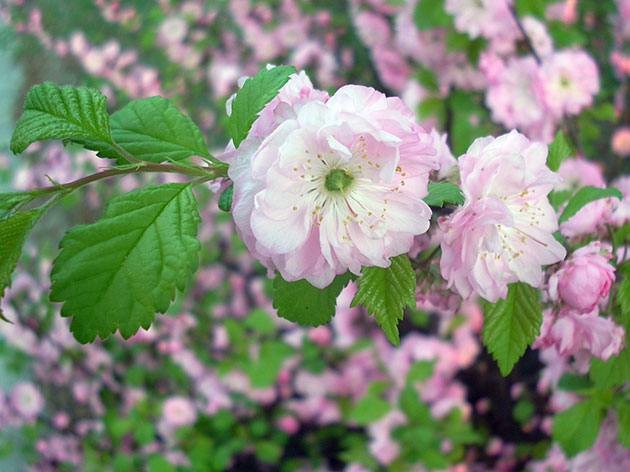
How almonds blossom.
According to some sources, the name of the plant came from the Greek word amigdalos, meaning "beautiful tree". This version is similar to the truth, because during the flowering the decorative almonds look amazing: almond flowers of white, red, purple or pink are located on branches in such abundance that the tree itself can not be seen. Fans of painting are familiar with Vincent van Gogh's "Flowering branches of almonds", but a real gardener will prefer to admire this spectacle not in the Amsterdam gallery, but in his own garden.
In a region with a warm climate, flowering begins at the end of January and lasts until March. In the middle band, the color of almonds appears in late April or early May and lasts about 2 weeks. During this period, it is very important to arrange regular watering for almonds, since from the lack of moisture flowering can be completed ahead of schedule.
Pests and diseases of the almond.
Of the diseases, almonds can suffer from klysterosporiosis, moniliosis, gray rot, scab and rust. Among the pests, spider mites, aphids, leaf-litter and almond seedlings are dangerous for him. Details about the symptoms of almond diseases and pest damage can be found in the article, which we already mentioned. Here we will briefly recall that from fungal diseases it is possible to get rid of almonds with such fungicides as Topaz, Skor, Fundazol, Kuproksat, and Insecticides Acetellic, Calypso, Fufanon, Zolon cope with insects. Spider mites are destroyed by the treatment of plants with Kleshchevit, Akarin or Agravertin.
But it is much more important than the timely processing of plants with chemical preparations, the implementation of agrotechnical culture, and the understanding that planting and caring for almond shrubs in accordance with the rules will save not only his health, but the health of your entire garden.
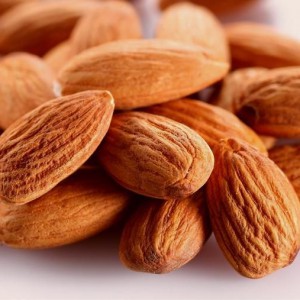
Almond in the winter.
Cooking almonds for the winter is necessary from the summer: pinching the tops of almond shoots speeds up their lignification, which allows the plant to safely survive the winter without freezing. Young seedlings should be sheltered for the winter with straw, dry leaves or lutrasil to a height of 15 cm from the ground. Make sure that the root neck does not stick out under the snow. Adult plants normally hibernate without shelter, but if even frosts damage some of the shoots, the almonds will recover fairly quickly.
Almonds in the Moscow region and in Moscow.
For cultivation in the climatic conditions of Moscow and the Moscow region, such types of almonds as steppe almonds, or low almonds, tri-lobed almonds, Georgian almonds and Ledebur almonds are suitable. Plants of these species, even if slightly and will suffer from frost during the winter, can quickly restore their strength and delight you with magnificent flowering. Planting almonds and caring for them in the Moscow region are no different from those described in our article.
Reproduction of almonds
How to multiply almonds.
Species almonds can be propagated by seeds, and varietal only by vegetative methods - grafting, layers and shoots. Gardeners, accustomed to rely on themselves in everything, prefer to grow seeds from their own stock to plant varietal cuttings on them.
Cultivation of almonds from the bones.
Seeds of almonds can be planted in the soil in autumn, and it is possible in spring, but before spring planting the seeds must pass stratification in the vegetable box of the refrigerator for 4 months. Sow the almond kernels in grooves depth of 8-10 cm, placing them at a distance of 10-12 cm from each other. The interval between the furrows is kept within half a meter. When the seeds germinate, look after the almond shoots, like any other: water, loosen the soil around them, remove the weeds. In summer, in the seedlings stretching to 50 cm with a stem thickness of about 1 cm, cut off all the branches on the ring, growing at a height of up to 10 cm from the root neck. Seedlings are transplanted to a permanent place, and once they have taken root, they can be vaccinated with varietal cuttings.
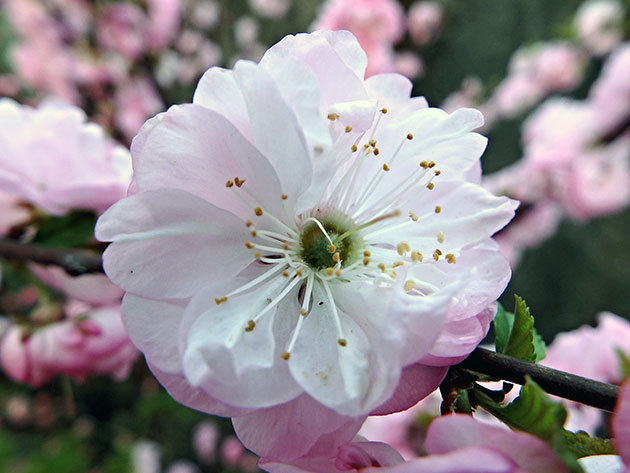
Inoculation of almonds.
For vaccination, it is possible to take rootstocks of any kind of almonds, but it is better to use the most winter-hardy species. The almonds grow well on the root of the turn, plumbers , plums and bird cherry. For the scion, you need to find a straight, well developed shoot of almonds with formed eyes. Leaves cut from the cuttings with a pruner, leaving only short petioles not more than 1 cm long.
Reproduction of almonds by grafting is carried out during the sap movement - in the spring or in August. Growing in the soil, the rootstock is wiped with a damp cloth from dust and dirt, make a T-shaped incision with the eyepiece knife on its bark just above the root neck, gently turning the cut bark to the sides.
With the cuttings cut off the flap - a strip of bark with a kidney and the thinnest layer of wood. The scutellum should be of such a length that it fits all under the bark of the T-shaped incision. After you insert the flap, press against it the edges of the turned bark and fix the place of inoculation with tape, eyepiece tape or patch, making several stitches around the trunk. The kidney itself with the remainder of the petiole should remain unopened.
After two weeks, if the kidney remains green, and the petiole falls away from it by itself, slightly loosen the fixing tape, but if you were not budding in the spring, and at the end of the summer, leave the tape for the rootstock until the next spring and bite the grafted sapling for the winter , hiding under it the place of vaccination. In spring, release the root neck from the ground and remove the fixing place of grafting the tape.
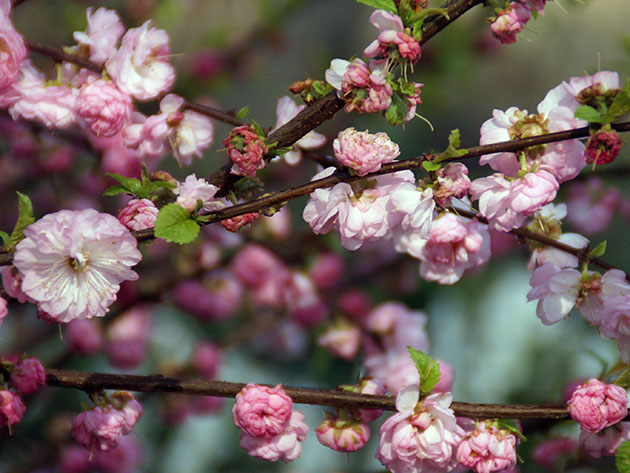
Reproduction of almonds by cuttings.
For cuttings of almonds, it is necessary in the second half of June to trim the apical half-aged cuttings 15 to 20 cm long with two knots and place them for 16 hours in a growth stimulant. Root cuttings in a cold greenhouse, planting in a substrate consisting of one part sand and two parts peat. Rooting occurs in 3-4 weeks. Seizes from 85 to 100% of cuttings. After the roots are formed, the cuttings are transplanted to grow into the training bed.
Reproduction of almonds by thickets.
The shoots around the almond bushes begin to form after a strong pruning. Separate the offspring for the second year, when they have already formed the root system. The excavated shoots are transplanted to a permanent place and they take care of it as if it were a one-year-old seedling.
Reproduction of almonds by layers.
Flexible shoots of almonds are bent to the ground, fixed with metal pins and sprinkled with soil. So long as the roots do not grow roots, they are watered, soil is loosened around them and weeds are removed. Not earlier than in a year, when the root system appears in the layers, they are separated from the mother plant and transplanted to a new location.
Kinds and grades of almonds
Almonds are ordinary.
In culture, almonds are grown as a fruit plant, which is divided into bitter almonds - wild almonds containing cyanide in the nuclei, and sweet almonds, which are grown in culture and contain no prussic acid. It is the numerous varieties of sweet almonds that are in demand both in amateur and in industrial gardening. Almond ordinary, maybe, and does not have high decorative qualities, but its nuts have high nutritional and medicinal value.
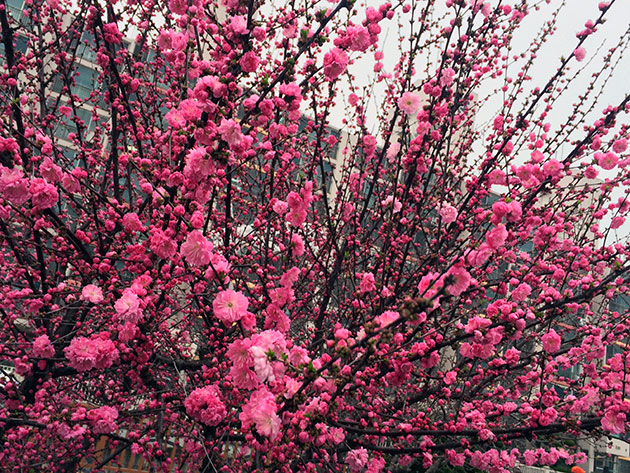
Details about this species and its varieties can be found in the article, which we already mentioned.
Almonds are low, or steppe, or a bean
- deciduous shrub up to 1.5 m high with a dense ball-shaped crown, erect branches with a reddish-gray bark, narrow lanceolate leathery leaves up to 6 cm long, dark green on top and lighter from below. Flowers in this species are bright pink, solitary. Flowering lasts 7-10 days. The fruit of the bean is edible. Almond is the lowest most popular species in the middle belt gardens. It has two forms - the white-flowered and the Gessler, which is smaller in size than the original view, but has larger flowers of bright pink color. Of the varieties of almond steppe cultivated in the middle band, the most known are:
- – White sail - as the name implies, it is a white almond with flowers up to 10 mm in diameter, copiously covering the branches of the bush;
- – Anyuta - a variety with bright pink flowers with a diameter of up to 25 mm;
- – Dream - almonds with flowers of soft pink color, reaching in a diameter of 25 mm;
- – Pink flamingo - a variety with double pink flowers up to 10 mm in diameter;
- – Pink fog - almonds with bright pink large flowers reaching a diameter of 25 mm;
- – Intermediary - the grade was created by Michurin. This tree is usually above 2 m with large flowers of pale pink color, which has high frost resistance.
Almond Georgian
- the Caucasian endemic, growing on the slopes, fringes and in the hollows. This plant is about 1 m high, similar in appearance to almonds low, but with larger leaves reaching a length of 8 cm, and larger bristly flowers of bright pink color. The species has good prospects for breeding and enough frost for growing in the Moscow region.
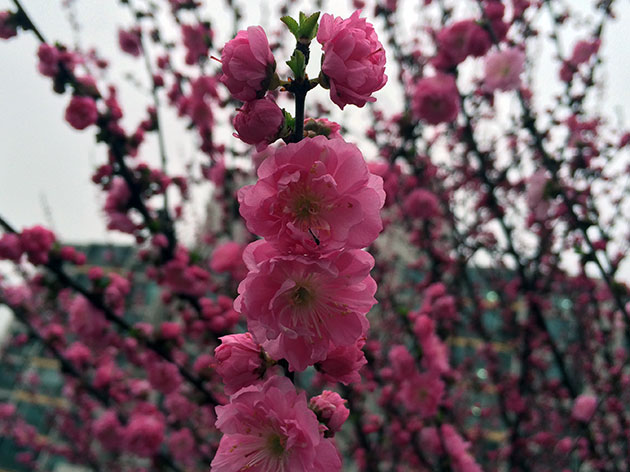
Almond Ledebour
in nature grows in the foothills of the Altai, forming whole thickets. The leaves of this species are large, dark green in color. Pink flowers open earlier than other species, and bloom for 2-3 weeks. The most famous variety:
- – Fire Hill - almonds with flowers of red-pink color up to 3 cm in diameter.
Almond Petunnikov
is the endemic of Central Asia. This is a shrub up to 1 m high with erect or sprawled branches with a gray-brown bark and light yellow shoots. Leaves of plants of this species are linear or lanceolate, with a pointed apex, obtuse-serrate along the edges. Single flowers are pink.
Almond trilobate
- Shrub up to 3 m high with a spreading crown, large-toothed along the edge of trilobate leaves, at the time of opening thickly fleecy from the lower side. Flowers up to 1.5 cm in diameter of different colors grow on shoots in pairs. The species has two decorative forms:
- – Captivity - terry almonds with flowers 3-4 cm in diameter. The pink petals of almonds of this form open after the appearance of leaves, which reduces the ornamentality of the plant;
- – Kievskaya - pink almonds up to 3.5 m high, blossoming extremely abundantly with double flowers with a diameter of 2.5-3.5 cm. The variety has a high degree of decorative due to the fact that the flowers appear on the bush before the leaves.
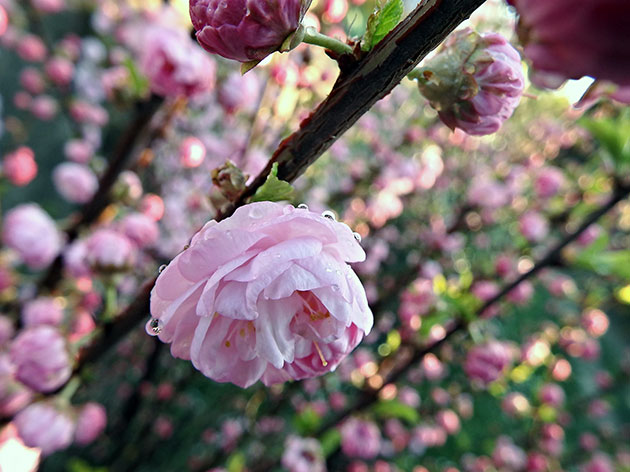
Almond trilobate
has many varieties and hybrids, differing not only in appearance and coloring of flowers, but also in flowering. The most interesting to us are varieties:
- – Svitlana - a variety of Ukrainian selection with very light flowers;
- – Tanyusha - almonds with dense flowers 2.5-3.5 cm in diameter with twisted petals; 4.5217391304348 Rating 4.52 (23 votes)
Almonds ordinary - Amygdalus communis L - a low tree or shrub of the family Rosaceae (Rosaceae) with a powerful root system, much larger than the size of the crown. The trunk is more or less branched, height 4-6 m. Shoots of two types: elongated vegetative and shortened generative. Leaves are alternate, lanceolate, greyish-green. Flowers single, with double 5-membered perianth, corolla white or light pink, stamens in each flower a lot - from 15 to 30, pestle with the top ovary.
Fruits - dry oval drupes with a velvety-pubescent gray-green inedible pericarp (the outer part of the fruit), which when dried, dries up and comparatively easily separates from the seed (seed). Bones in life are called almonds. They are oval in shape, 2.5 - 3.5 cm long, their shells are covered with shallow dimples, and sometimes grooves. There are many forms that differ in the strength of the stone, from very strong, rather thick to kneading fingers, almost paper-like. The weight of one nut (seed) is from 1 to 5. The almonds are divided into two types according to the chemical composition of the nuclei: sweet (Amygdalus communis var. Dulcis DC.) And bitter (Amygdalus communis var. Amara DC.). The difference between them is mainly only in the chemical composition and, accordingly, is most palpable precisely to the taste of the nucleus, according to morphological features, both varieties are practically identical.
Blossoms almonds very early - in March-April, before the leaves blossom. Fruits ripen in June-July. It is distinguished by its exceptional drought resistance and photophobia. Fruiting almonds begins from 3 to 4 years, the maximum yield yields 20-30-year-old trees. They live 50 - 65, and according to some sources - up to 130 years. The almonds reproduce in natural conditions and even in culture, mainly by seeds, but also vegetative reproduction by root offspring.
Wild almonds ordinary occurs in Asia Minor, the Caucasus, Iran, Afghanistan, Central Asia. Introduced into culture in the Near East for many centuries before our era. From there the culture spread widely to neighboring countries, and then to more distant countries. Before the new era was already grown in Ancient Greece, the Roman Empire, North Africa, the Iberian Peninsula. To date, almonds are cultivated throughout the subtropics and partly in the mountainous regions of the tropics. He became one of the main nut-bearing crops. The yield of nuts on plantations is from 10 to 25 c / ha.
In Russia, plantings of almonds are carried out mainly in the Krasnodar Territory and the North Caucasus. The limiting factor in the cultivation of almonds is, strangely enough, not so much its heat-loving as the extremely early flowering, as a result of which flowers often die in recurrent spring cold snaps, not to mention frosts. Adult trees in a leafless state tolerate short-term winter frosts to -25 ° C.
Economic use of almonds
Kernels of bones (nuts) of almonds is a valuable food product. They contain 40 - 60% fatty oil and 20 - 30% protein. They cultivate a predominantly sweet variety, called sweet almonds. Its kernels are eaten fresh, toasted, salted, used to make cakes, cakes, marzipans, some types of chocolate and expensive sweets, and a number of other confectionery products. Of these, the oil used in the food and perfume industry, as well as in pharmacy, is squeezed out. The cake remaining after pressing the oil is a concentrated pet food. Before feeding, essential oil is distilled from it (yield up to 0.8%), which is perfumed with perfume.
A bitter variety (bitter almonds) is of no nutritional and fodder value. Moreover, its nuclei are poisonous, since they contain 2.5-3.5% of amygdalin glycoside, which is degraded in the body by glucose and poisonous hydrocyanic acid. The oil of bitter almonds is used only in soap making, and even then it is previously cleared of amygdaline. However, bitter almonds are important as a source of medicines.
The wood of the almond trunks is dense, strong, with a reddish tinge, it is well polished. It is used to make valuable carpentry and souvenirs. Almond is a good honey plant, giving early bribes of nectar and pollen to one of the most important for the bee family time when it recovers from the winter. Almond blossoms are distinguished by exquisite beauty, which encourages many artists (especially the Oriental) to imprint it in their works. Let us recall the words of our famous writer K. Paustovsky on flowering almonds: "No tree has a more touching and pure flowering than almond."
Medicinal value of almonds and methods of therapeutic use
Almond since ancient times used as a medicine. The nuclei of sweet and bitter almonds, gum, seed oil, and almond root cortex were used. The almond kernels were mainly recommended as a general restorative, anti-inflammatory, wound-healing, emollient, cosmetic and antivenomics.
Arab doctor Ibn Massui used roasted almonds for bowel diseases, and another Arab doctor, Abu Mansur, used almonds in cases of painful urination, and along with sugar, to increase sperm.
According to Avicenna, all kinds of almonds are cleaned, cleaned and unclogged in the liver, spleen, kidneys, but sweet almonds are weaker than bitter. The intake of almonds with a fresh peel cleanses the stomach. Almond oil with a violet root cleanses the kidneys, bladder, crushes stones. Almond strengthens the eyesight. Bitter almonds with wheat starch help from hemoptysis and are useful for chronic cough, asthma and pleurisy. Oatmeal from almonds helps with coughing and hemoptysis.
The reception of bitter almonds in an amount of 5 pieces before drinking prevents the intoxication.
Bitter almonds are used for freckles, sunburn spots, bruising, and in combination with wine for hives. Decoction of the roots of bitter almonds locally or in the form of ointments has an effective effect against freckles. A batch of bitter almonds knits and warms. Almond oil helps in the treatment of swelling of the female breast and sprain. It is most useful for pain and noise (ringing, whistling) in the ears. 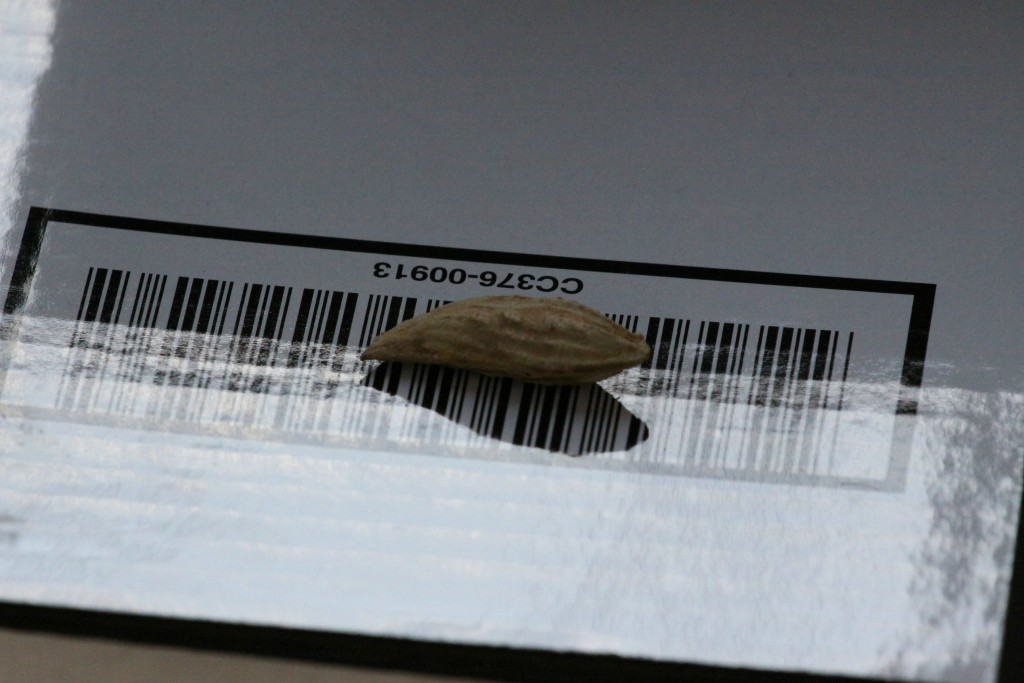
According to the descriptions of Muhammad Hussein Sherazi, almonds cleans the internal organs, strengthens the brain substance, vision, is useful in asthma (along with sugar), pleurisy, with abrasions and ulcers in the intestines, gives the body fullness. Jam with almonds is highly nutritious and very useful for the kidneys.
In folk medicine apply seeds of sweet almonds, almond oil, flowers and leaves of this shrub. Almond oil for 0.5-2 tablespoons is used as a laxative and normalizing agent for constipation, in the treatment of chronic gastritis and colitis, chronic bronchitis.
In Tajik folk medicine, the seeds of sweet almonds are used to treat jaundice (Botkin's disease) according to the following scheme.
The patient on the first day appoints 5 pcs. peeled almond seeds 2-3 times a day before meals. In each subsequent day, the dose of seeds is increased by 5 pieces. Thus, on the 4th-5th day, patients receive about 70 seeds, after which the daily dose of seeds is brought up to 15 pieces in the same sequence. and only then stop treatment. 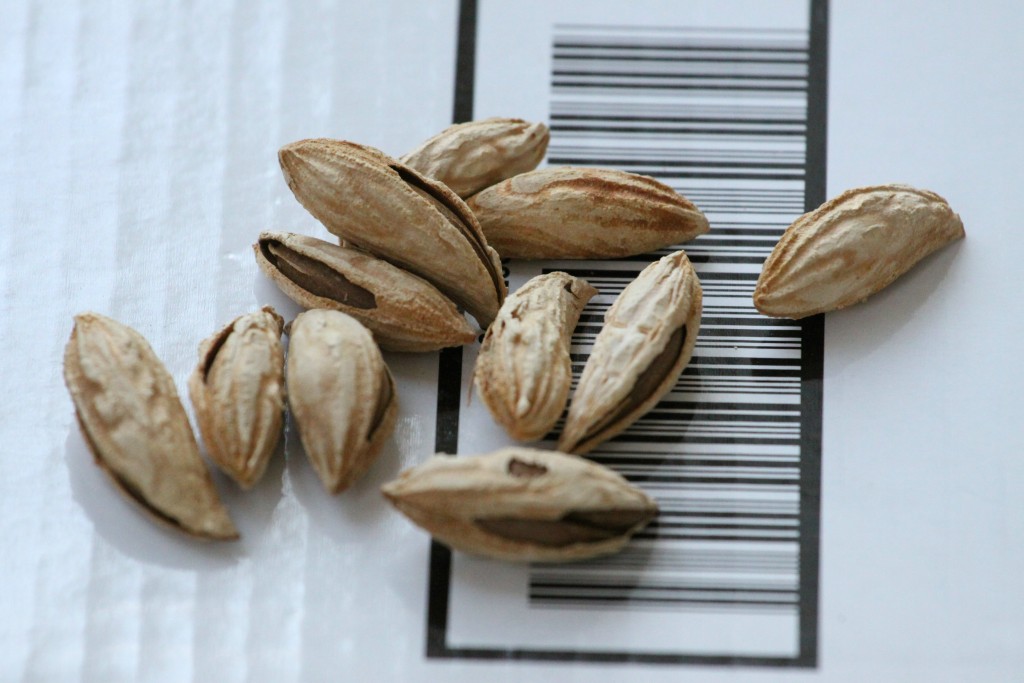
Almond oil for 2-3 drops 2 times a day in a heated form is used to treat ear pain.
Locally it is used as an emollient and nutritious remedy for lubricating the skin.
Almond oil is used in the treatment of breast tumors, inflammation of the lungs and other inflammations. Operates in a cooling manner-
Such patients should be given 1 tablespoon of oil 3 to 4 times a day.
When the noise in the head, acute pain or hardening of sulfur in the ears, you need to drip 6-7 drops of oil in a sick ear and plug it with cotton.
Those with hearing damage due to a cold or rheumatic seizures should use almond oil in the following way.
On the first day, pour 7-8 drops into one ear, and on the second day, as many drops in another and each time stopping the ear with cotton. After a few days after the disease, rinse your ear with warm water.
If the tumor is accompanied by severe inflammation, it is necessary to rub it with almond oil - it soothes acute pain and cools the intense heat.
At present, almond oil is widely used, for the production of which seeds of both sweet and bitter almonds are used. It is used as a solvent for the preparation of injection solutions of drugs, as well as as a base in ointments and emulsions.
Assign inside as a gentle laxative.
From the grinded kernels of the seeds of sweet almonds, a special emulsion was made-almond milk, which has an enveloping and analgesic effect. This medicine is used for various diseases of the gastrointestinal tract. It has been established that almonds depress the secretion of gastric juice, which makes them a promising medicine for patients with gastric ulcer and duodenal ulcer. 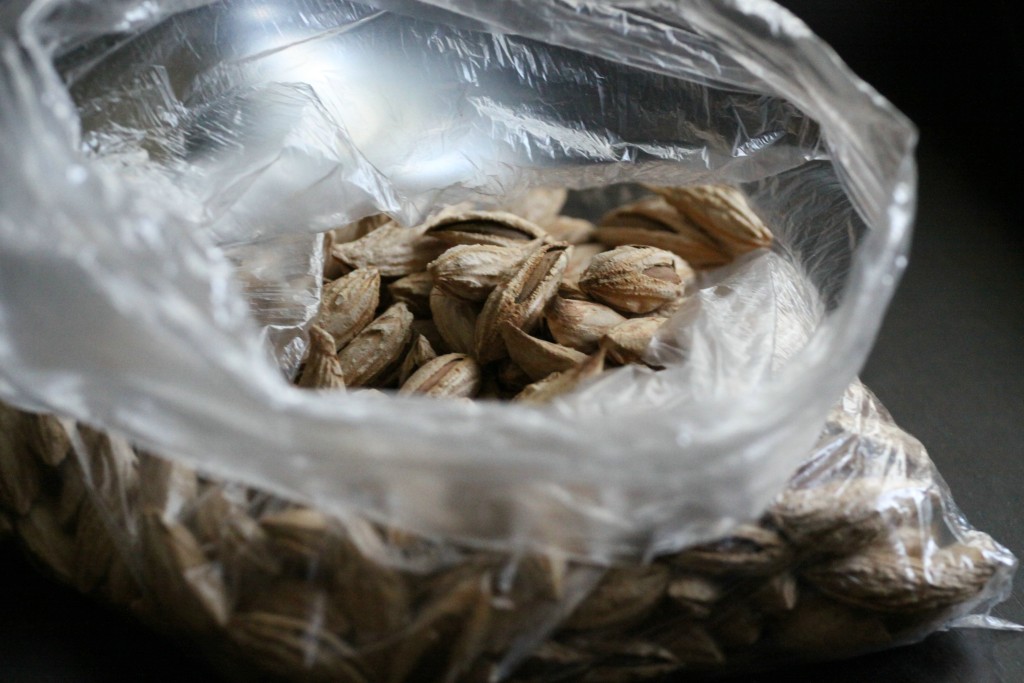
The cake remaining after the extraction of oil from the kernels of sweet almond nuts is used as a cosmetic agent that softens the skin.
To do this, take 2 tablespoons chopped cake (almond bran), pour them 2 - 2.5 cups of boiling water and leave to infuse before cooling. The filtered liquid is washed by the face or other parts of the body, whose skin is intended to be softened.
The cake of bitter almonds serves to obtain the so-called bitter water.
As an analgesic and soothing agent and with nervous disorders, abdominal pain, painful cough, patients are prescribed 10-15 drops of bitter-mixed water, prepared from almond bran, inside.
Crushed seeds of sweet almonds mixed with sugar, used for anemia, coughing, insomnia, headache, numbness of hands or feet and cramps.
The intake of almonds with a fresh peel cleanses the stomach. 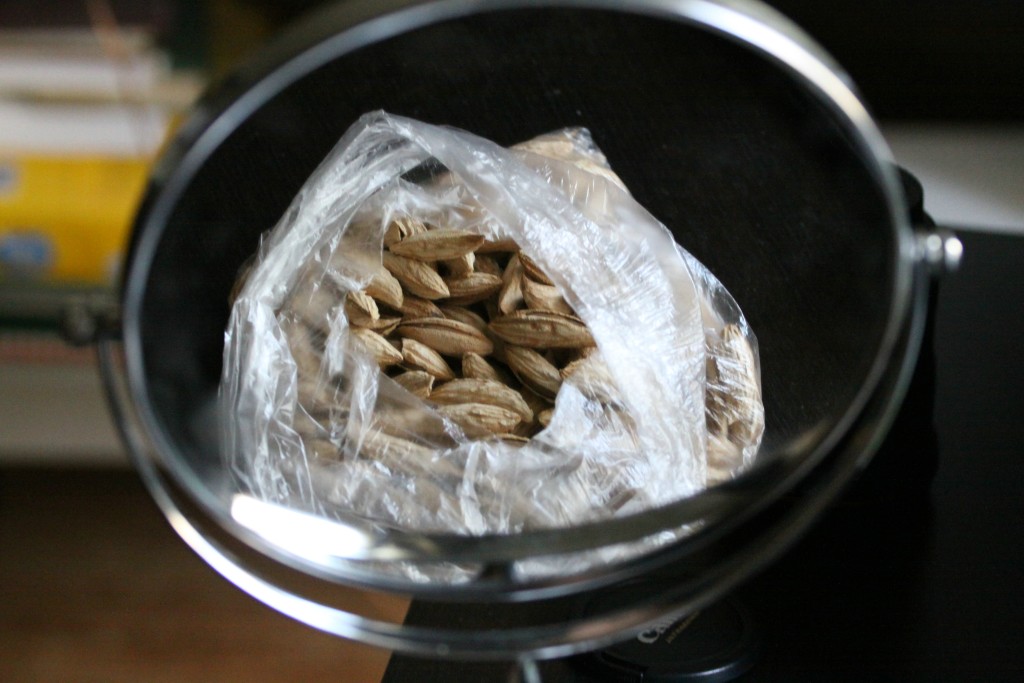
Seed skin of almond fruit ("shell of nuts") - raw materials for the production of first-class medical adsorbent coal.
Freshly prepared gruel from flowers or fresh almond leaves freckles, pigment spots, treat abscesses and other pustular skin processes.
Precautions: after the intake of bitter almonds, poisonous substances such as hydrocyanic acid and benzoic aldehyde are formed under the action of the emulsion enzyme. Under the action of prussic acid, the activity of respiratory tissue enzymes paralyzes. From large doses, death occurs in a few minutes as a result of paralysis of the respiratory center. Particularly sensitive to the action of hydrocyanic acid are children who can easily get poisoned even from a small amount of seeds of sweet almonds or bones of cherries, plums, etc., which also contain amygdalin glycoside. In case of poisoning with seeds of bitter almonds before the doctor comes, wash the stomach with a solution of potassium permanganate (1: 1 LLC). The victim is given 0.5 to 1 liter of a solution of potassium permanganate, painted in a bright red color, and causes mechanical vomiting. This procedure is carried out several times. With severe poisoning, qualified assistance is required.
The almond tree contains the forces of Venus, Jupiter, and the Sun.
| Name | Nutrient content in 100 grams of product, milligram |
|---|---|
| Vitamins | |
| 52,1 | |
| 24,6 | |
| 6,2 | |
| 1,5 | |
| 0,65 | |
| 0,4 | |
| 0,3 | |
| 0,25 | |
| 0,04 | |
| 0,02 | |
| 748 | |
| 473 | |
| 273 | |
| 234 | |
| 178 | |
| 39 | |
| 10 | |
| 4,2 | |
| 2,12 | |
| 1,92 | |
| 0,14 | |
| 0,091 | |
| 0,0025 | |
| 0,002 | |
From the almond kernels produce oil, and flour, which are widely used in the food, cosmetic industry, folk medicine. Sweet nuts are used in salted, roasted and raw form. It is placed in the confectionery (cakes, cookies, cakes, ice cream), meat dishes and. Whole roasted almonds are used to decorate baking, as well as enhance the taste of sweets, chocolate. A crushed is introduced into the composition of butter, ketchup, pasta, jam, glazed curd cheese and curd mass, to give products of nutty flavor and aroma.
Almond on the guard of health
 Since ancient times, the nuclei of the plant have been used as a medicine for combating diseases of the intestine and urogenital system.
Since ancient times, the nuclei of the plant have been used as a medicine for combating diseases of the intestine and urogenital system.
Beneficial features:
- Protects cells from the damaging effect of free radicals, resists premature aging of the body.
- Lowers the level of sugar and insulin. Recommended for use by diabetics.
- Maintains heart health. Clears blood vessels, neutralizes the risk of cholesterol plaque formation.
- Prevents the development of osteoporosis.
- It serves the prevention of Alzheimer's disease.
- Cleanses the blood, removes bile, removes sand from the kidneys.
- It increases stress resistance, improves brain activity, helps to get rid of chronic insomnia.
- Stimulates the production of male hormones, enhances potency.
- Strengthens teeth, nails, improves hair growth.
- Prevents development of tumors.
- It is necessary for the correct formation of the neural tube of the fetus and the placenta (for pregnant women).
- Opens the blocked ducts in the spleen and liver.
- Relieves the symptoms of a hangover.
Almond kernels are a natural analgesic. This is a natural anticonvulsant. In addition, the fruit of the bush has an enveloping, choleretic and analgesic effect.
 The fruits of sweet almonds are recommended for:
The fruits of sweet almonds are recommended for:
- insomnia;
- slagging of the organism;
- urolithiasis;
- problems with potency;
- gastritis;
- stomatitis;
- pneumonia;
- bronchial asthma;
- lag in development;
- anemia;
- anemia;
- headaches;
- numbness of hands and feet;
- coughing.
The nuclei relieve attacks of severe cough, reduce the acidity of gastric juice.
Harm to the body
product. People suffering from excess weight should refrain from eating nuts, because they can quickly and unnoticeably increase body weight. In addition, unripe almonds are strictly forbidden to eat for all categories of people, because it contains toxic cyanides incompatible with life.Contraindications:
- individual intolerance;
- obesity;
- high heart rate.
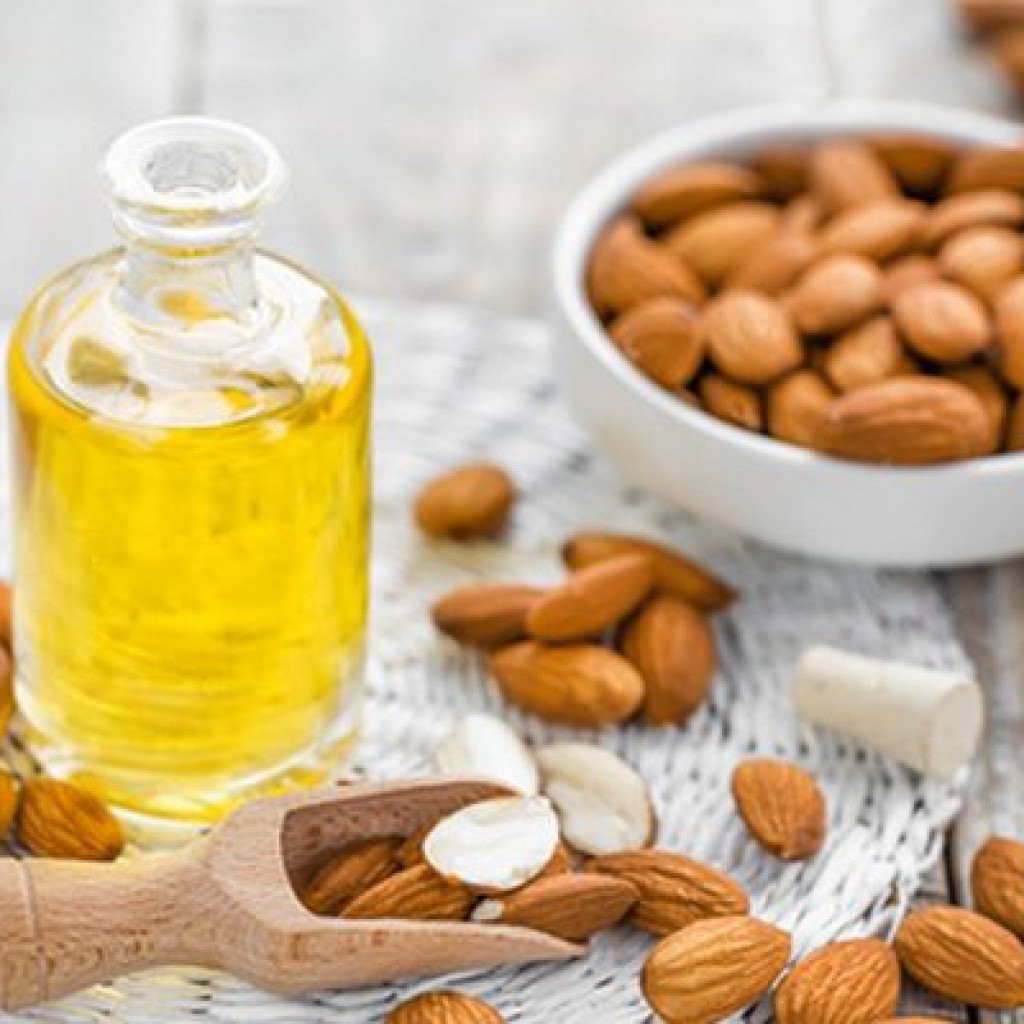 The seed of the almond stone contains 40-60% of the oil, depending on the variety, the conditions of growth. It is extracted by cold pressing.
The seed of the almond stone contains 40-60% of the oil, depending on the variety, the conditions of growth. It is extracted by cold pressing.
Composition of almond oil:
- amygdalin glycoside;
- tocopherol, riboflavin;
- protein substances;
- sahara;
- carotene;
- mineral compounds: zinc, phosphorus, magnesium, sodium, iron;
- linoleic acid (16-25%);
- oleic acid (65-83%).
Almond oil is a universal product. Currently, it is used for cosmetic and therapeutic purposes. It acts more efficiently than olive. It is taken orally to reduce the level and acidity of gastric juice, to eliminate flatulence.
Outer, almond oil is used to treat sunny, thermal domestic burns, minor injuries, improve the skin condition. In addition, it is used to prepare warming compresses to relieve pain in the ears. For better absorption, the product is preheated to 36-40 degrees.
Almond oil has a laxative, soothing, softening, anti-inflammatory, analgesic, regenerating and wound-healing properties.
The product is used in cosmetology for the care of dry, loose, normal and tired skin.
Folk recipes of beauty
- For nutrition, skin refreshing. Combine in equal proportions essential oils of patchouli, lavender, rosewood and almonds. Apply to damp skin for 15 minutes. Remove the residue with a tissue.
- Toning mask. Oat flour (30 g) is diluted in hot water to a creamy mass, add almond oil (5 ml), essential oil of rosemary and lemon (2 drops each). Leave the mask for 15 minutes, rinse.
- Cleansing (for dry, normal skin type). Ingredients: yolk (1 piece), almond oil (15 drops), water (5 ml). All components are mixed, leave on the face for 20 minutes, rinse.
- To smooth wrinkles, nourishment and eliminate dark circles under the eyes. Almond oil to put on the skin of the eyelids with the pads of fingers, with light tapping movements. Wait until absorbed.
- For regeneration and moisturizing. Method of preparation: essential oils of sandalwood, neroli (2 drops each) mixed with almond kernels oil (15 ml), applied to the skin. After 20 minutes, remove the remainders with a cotton disc.
- For refreshing and improving the complexion. The mask is suitable for oily skin. For the preparation of essential oils of citrus, ylang-ylang mix 2 drops, add 15 ml of warmed almond oil. The agent is applied to the face for 10 minutes, removed with a cotton disc.
- To increase the elasticity of the skin and prevent the appearance of stretch marks. To make a massage mixture of essential oils of mandarin, neroli and lavender mix 4 drops, inject 100 ml of almond oil. The agent should be applied to the hips and abdomen starting from the 5th month of pregnancy.
- For nutrition, healing of cracked skin of hands. Almond oil is heated to 38 degrees, massaging movements rubbed into the dermis. Preferably, the hand mask should be applied overnight, if necessary, cotton gloves should be worn. Do not rinse.
- For elasticity, shine and stimulation of hair growth. It is recommended to use oil for make-up. To do this, wadded disk moistened in the composition, gently rub the skin of eyelids, eyelashes. After cleansing the eyes, rinse your face with water.
For the care of oily hair, almond oil is mixed with essential oils of cedar, bergamot and lemon (2 drops each). The resulting composition is rubbed into the roots, then distributed along the entire length of the curls before washing the head. If the hair is dry, the product is applied to washed wet strands. At the same time, essential oils are used patchouli, lavender or ylang-ylang.
To achieve a lasting effect, oil compositions are applied to strands at least 1-2 times a week. To feed the hair fiber fat from the almond kernels can be applied to the comb, combing the hair three times a day. To reduce the fragility of nails and restore their strength, almond oil (5 ml) is combined with essential oils of ylang-ylang and lemon (1 drop). The agent applies daily to the nail plate. From herpes, almond oil (5 ml) should be mixed with essential oil of eucalyptus or tea tree (2 drops). The resulting composition grease rashes up to 5 times a day. For the prevention of atherosclerosis, daily consume 5 ml of almond oil for 3 months.
Thus, oil from almond stone, obtained by means of cold pressing - a miracle cure, which stands guard over women's health and beauty. By its properties, the unique product quenches the painful sensations of menstruation, prevents the appearance of stretch marks during pregnancy, nourishes, moisturizes and rejuvenates the skin, strengthens the nails, stimulates hair growth. On the basis of oil, home masks, compresses are prepared. In addition, it is introduced into the composition of ready-to-use cosmetic products for the skin care of the face and the body (cream) for the vitaminization of the product.
It is a delicious and nutritious drink with therapeutic potential. Squeezed almonds are an alternative to cow's milk, but it is not able to provide the human body with calcium (2 mg vs. 300 mg) and protein (1 g vs. 8 g).
By the amount of vitamins and mineral compounds surpasses the soy and rice product.
The positive properties of almond milk:
- Prevents heart disease: lowers blood pressure, supplies the body with useful fatty omega acids.
- Does not add weight. In 100 ml of almond milk contains 2 times less calories than in whole cow (30 kcal). Thus, it is a dietary drink that allows you to keep or reduce the current weight.
- Improves the skin condition, protects it from the negative effects of the sun. Interestingly, 100 ml of almond milk contains 50% of the daily dose of vitamin E.
- Strengthens bone tissue, serves as a preventive measure for the development of osteoporosis and arthritis. Provides dental health.
- Reduces the risk of developing diabetes. Almond milk refers to low-carbohydrate foods with a glycemic index of 30. Consequently, it does not provoke a sharp release of insulin into the blood and sugar, respectively.
- Strengthens muscles.
- Improves digestion. In addition, milk from almond kernels does not contain lactose, from intolerance to which, more than 10% of the adult population of the planet suffer.
- Strengthens eyesight, increases the ability of the eye to adapt to different lighting.
What kind of culinary bonuses is the product
 Does not require cooling. Magazine almond milk can be stored at room temperature, while preserving the freshness and nutrients in its original form.
Does not require cooling. Magazine almond milk can be stored at room temperature, while preserving the freshness and nutrients in its original form.
Tastier than the cow. A distinctive feature of almond milk is a unique aroma, fresh nutty taste.
Easy to cook. Unlike the whole cow, almond milk can not be cooked at home independently. To do this, you do not need to keep cattle in the stable or grow the fields of the plant. It is enough to buy sweet almonds, finely grind with a coffee grinder or blender, mix with water, separate cake from the nutrient liquid.
Recipe
The amount of ingredients is taken for 4 servings. Duration of preparation - 12,5 hours, of which 12 hours are for soaking almonds.
Components:
- maple syrup - 15 ml;
- raw unpeeled almonds - 1,5 cups;
- vanilla extract - 2.5 ml;
- water - 600 ml;
- , (in powder),.
Principle of preparation:
- Place the almonds in a bowl, pour cold water to cover it for 2-3 cm. Infuse 12 hours. Drain the water.
- Swell the nuts in a bowl of blender, add 200 ml of water at room temperature, turn on the device for 1 minute. The finished mixture should have a consistency of a thick homogeneous paste.
- Almond mass put in a bowl, pour 400 ml of boiling water, brew for 10 minutes.
- Strain the mixture with a strainer, gauze or fine-mesh filter. Then wring out the nutrient fluid from the cake. The almond pulp is not thrown out, it is useful for making cocktails and dietary cookies.
- In the filtered cold almond milk, add maple syrup, salt, cinnamon, nutmeg and vanilla. Beat with a mixer.
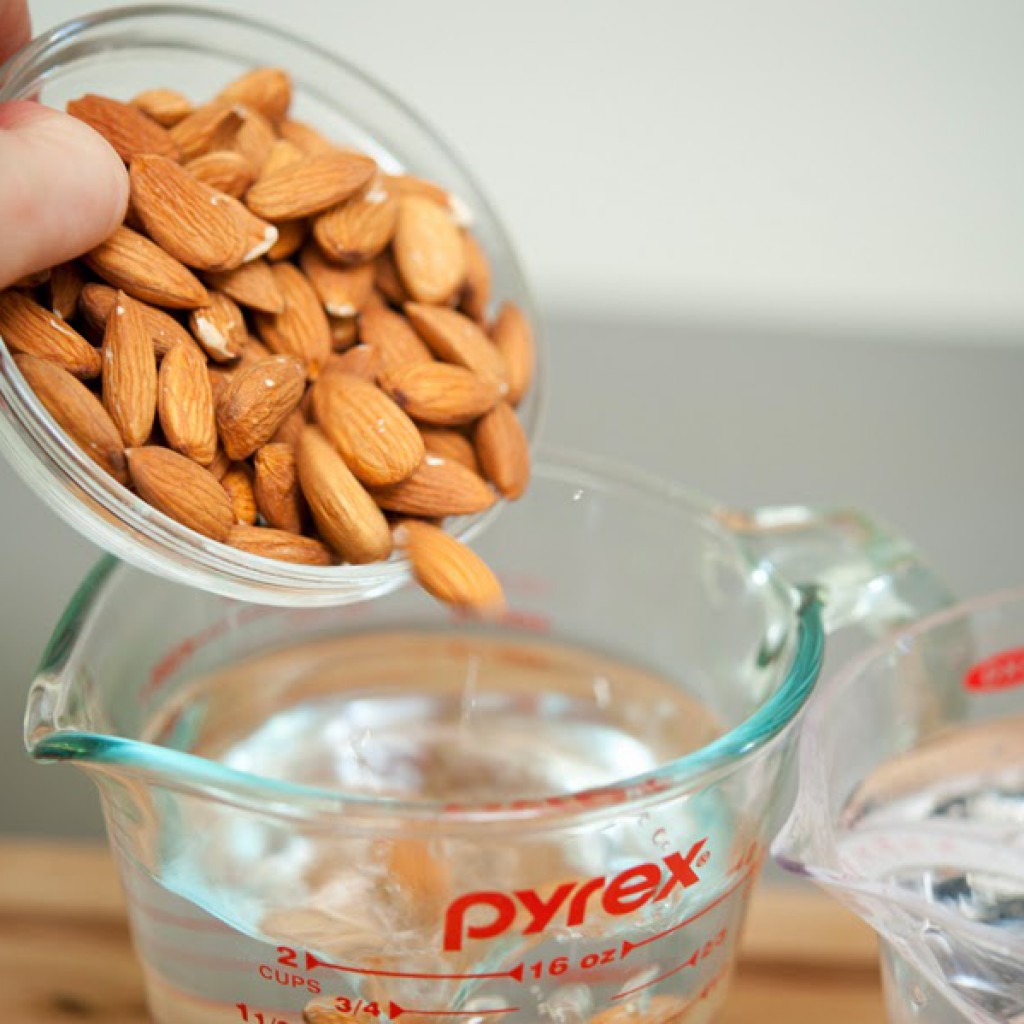 Unlike the store product, homemade almond milk should be stored in a sealed, closed container for no more than 2 days in a cold place. It is not recommended to give to babies, as it can provoke the development of an allergic reaction to nuts.
Unlike the store product, homemade almond milk should be stored in a sealed, closed container for no more than 2 days in a cold place. It is not recommended to give to babies, as it can provoke the development of an allergic reaction to nuts.
Carefully choose the main ingredient. Milk from almonds, prepared from unripe, bitter nuts can harm the body. Possible such reactions: violation of the heart rhythm, light narcotic intoxication, headaches, overexcitation.
First of all, when buying shopping almond milk, pay attention to the composition of the product. Some manufacturers add food additive carrageenan to it, for thickening, stabilization and gelation. It is obtained from red seaweed. For a long time, carrageenan was considered a safe ingredient, however, in recent studies it has been found that it burdens the course of coronary heart disease, ulcerative colitis, Crohn's disease, and causes inflammation in the digestive tract. In this regard, the EU banned the use of food additives in baby food.
Remember, the most valuable for the human body is provided by a product prepared independently without the use of chemicals, preservatives, emulsifiers and stabilizers.
The product obtained as a result of processing the nut pulp. Almond flour is hygroscopic, it has a good ability to absorb, retain moisture. Confectionery and bakery products cooked on its basis, last longer keep freshness. The chemical composition and caloric content of the product are the same as those of almonds. Interestingly, useful nut kernel components are retained even after heat treatment. In addition, almond flour practically does not contain gluten, which means it is suitable for people sensitive to a complex protein of cereal crops. It is recommended to use it for anemia, seizures, visual impairment, insomnia.
In contrast to high-grade cereal flour depleted of vitamins, almond contains carotene, tocopherol, choline, niacin, pyridoxine, thiamine, riboflavin, pantothenic and folic acid, magnesium, calcium, potassium, phosphorus. As a result, dishes made from nut powder have higher nutritional value, it is more useful for the human body.
 What can be prepared from almond flour:
What can be prepared from almond flour:
- french pasta macaroons;
- desserts franzipan and marzipan;
- cream;
- biscuits and spices, cakes, cakes;
- biscuits, sweets;
- puddings;
- casseroles, porridges, pates.
In Mediterranean cooking, almond flour is used not only for the preparation of sweet foods. It is introduced in the first and second courses, added to sauces, fillings for snack cakes. It is a universal product for thickening almost any dish. People who adhere to a low-carb diet and proper nutrition, use almond powder instead of refined flour, to prepare the basis for dough and breading.
How to make at home
The technology of almond flour production depends on what you want to get "out". There are only two options.
From raw almonds
Has a brown color, which does not play a key role during the preparation of baked goods, salads. Often the flour from unmelted almonds is mixed with chocolate and added to the dough, cream. In this case, the preparatory stage involves the picking of the nuclei (separating the qualitative from the spoiled ones) followed by washing in cold water.
From peeled almonds
A characteristic feature of the product is a white color. Used when creating a biscuit test, delicate desserts, in which the use of brown flour is not allowed.
The preparation of white nut powder is a laborious process, since it involves the purification of almonds from the skin. First of all, fill the pan with hot water, pour the nuclei into it, leave it for 5 minutes. Then drain the liquid, rinse under running cold water. Repeat this procedure, increasing the interval of almond holding in boiling water to 10 minutes. After the second time the steamed skins will be removed effortlessly.
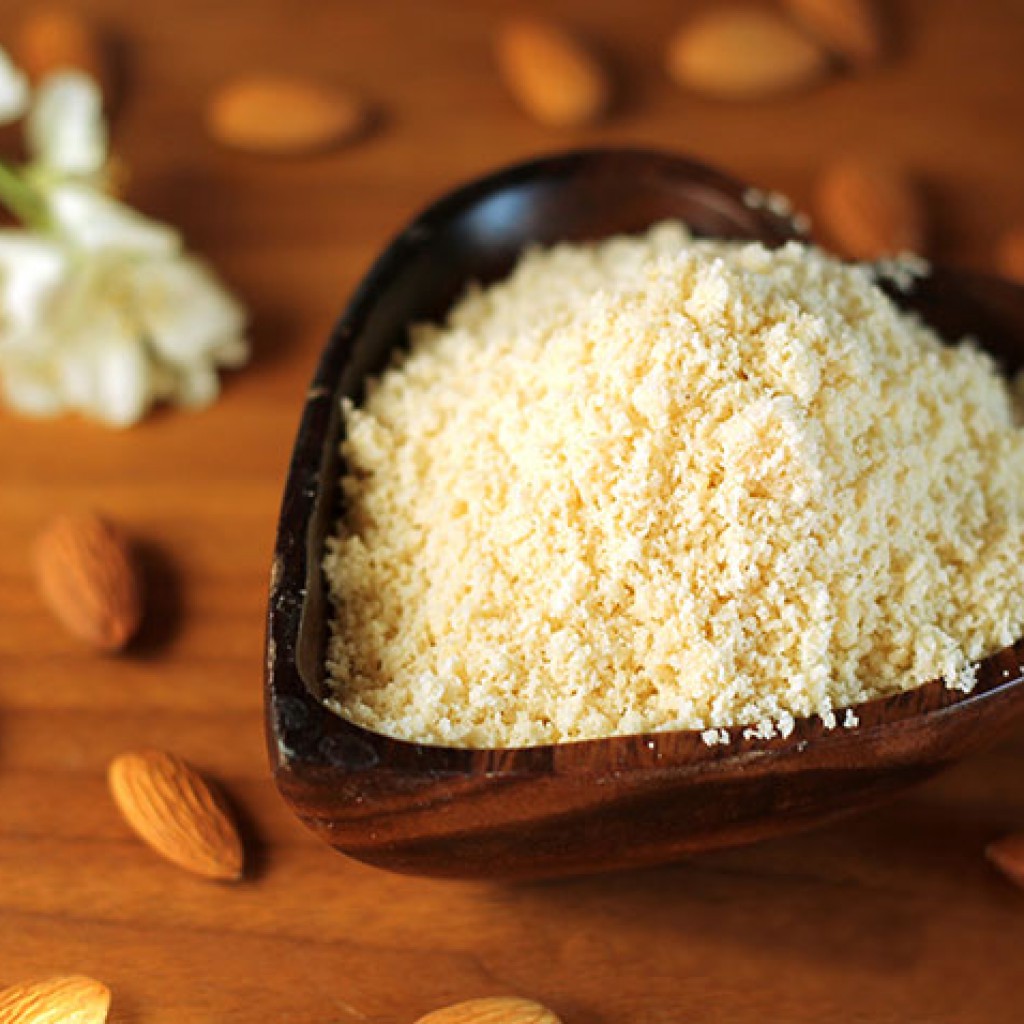 Remember, before grinding, the removed washed almonds should be dried, otherwise you will get a nut mash instead of flour. To do this, preheat the oven to 70 degrees, cover the pan with parchment paper, distribute the cores (previously cut into 2-3 parts) over the surface, hold no more than 20 minutes. Take care that they are not burnt. Dry the almonds and cool them, start grinding.
Remember, before grinding, the removed washed almonds should be dried, otherwise you will get a nut mash instead of flour. To do this, preheat the oven to 70 degrees, cover the pan with parchment paper, distribute the cores (previously cut into 2-3 parts) over the surface, hold no more than 20 minutes. Take care that they are not burnt. Dry the almonds and cool them, start grinding.
Methods of grinding the nut into flour
In a blender
Dried almond kernels should be placed in the blender bowl (not more than half its volume). Turn on the device for 20 seconds at medium speed. Then knock on the walls of the bowl to shake off the sticky pieces of flour. Switch the unit back on for 30 seconds. Ready almond meal to knock off the walls of the bowl.
In a coffee grinder
The grinding of sweet grains into this method requires a special approach, but the final product will be very delicate and gentle. Almond is shredded in short series for no longer than 20 seconds with breaks between each approach. If the coffee grinder will work too long, its blades will heat up and turn the powder into a paste.
In the meat grinder
The almond kernels are scrolled several times to break down the large particles that have escaped.
The finest grinding is obtained if you grind the grain with a coffee grinder, and the coarse grinder is a meat grinder. Almond flour is recommended to use immediately after cooking, because after a while it cakes into lumps and loses its nut flavor. Despite the fact that fatty acids do not rancid (they are in stable form), oxidative reactions are better prevented. For this, the almond flour is poured into a glass jar, tightly closed with a lid, stored in the refrigerator for no more than 2 months.
Recipes with almond flour
"Strawberry French cookies Macaroon"
 Ingredients:
Ingredients:
- lemon juice - 20 ml;
- sugar - 360 g;
- food coloring - 4 g;
- almond flour - 255 g;
- dried lavender flowers - 5 g;
- strawberry puree - 230 g;
- - 5 g;
- powdered sugar - 240 g;
- soybean powder - 10 g;
- water 180 ml.
Cooking method:
- Stir the mashed potatoes, add 15 g of sugar and pectin powder. Bring to a boil, sweeten another 100 g of sucrose, boil 10 minutes over low heat. Add the flowers of lavender, lemon juice.
- Pour the saucepan with strawberry puree from the heat, cool it.
- Heat water (120 ml), add sugar (80 g), soybean powder, beat until a uniform foam is obtained.
- Prepare the syrup from the water (60 ml) and sugar (170 g). Pour soy foam with a thin stream.
- Mix the powdered sugar, dye and almond flour. Put into soy mixture, stirring constantly.
- Fill the pastry bag with a ready-made dough (it should drain off the shovel and shine), cover the pan with parchment paper. Form small-sized tortillas.
- Baking tray with macaroons put in the oven for 30 minutes, maintain the temperature 150 degrees.
- Cool the flat cakes, combine the two halves with a warm lavender-strawberry cream.
 Ingredients:
Ingredients:
- wheat flour - 25 g;
- powdered sugar - 250 g;
- almond flour - 100 g;
- protein from 3.
Technology of preparation:
- Mix sugar powder with almond flour and proteins. Ingredients beat to a monotonous state.
- Wheat flour sift, add to the sugar mass. Knead the dough. Ensure that it has a liquid consistency.
- Cover the parchment with parchment.
- Confectionery bag filled with dough, otsadit round biscuits. Remember, during cooking it will increase in size, so leave between them a distance of 3 cm.
- Heat the oven to 180 degrees. Put the baking tray in the oven. Bake for 20 minutes. The appearance of a golden brown crust indicates the availability of cookies.
 Ingredients:
Ingredients:
- butter - 25 g;
- - 100 g;
- peeled almonds - 80 g;
- condensed milk - 1 jar;
- coconut shaving - 200 g;
- cocoa powder 100 g.
Formulation:
- Melt the butter on a water bath, add condensed milk and cocoa powder, stirring constantly the mass.
- Add the hazel beans to the sweet mixture.
- Chocolate mass cool, form the balls, put inside the almond nut, each outside to roll in coconut shavings.
Conclusion
Almond is the keeper of beauty and human health. First of all, the product is useful for the weaker sex. In cosmetology it is used in the form of oil to fight cellulite and stretch marks. Fat, extracted from almond kernels, nourishes, moisturizes the skin, makes it supple, promotes cell regeneration, improves the condition of the hair, nails. With regular external application, the hair becomes thick, strong, shiny and silky. In addition, almonds are a storehouse of calcium, vitamin E, zinc, iron, phosphorus, magnesium and folic acid. Therefore, pregnant and lactating women are recommended to include the product in the daily diet. It eliminates digestive disorders that often occur after childbirth, has analgesic effect, participates in the formation of the neural tube of the fetus.
Value provides not only almond oil, but also the shell. It is grinded into powder, added to cosmetics as an exfoliating dermis agent. In addition, milled shells are introduced into wines, liqueurs and brandies for the flavoring of alcoholic beverages. And cake, left after the production of fatty oil, found its application in the perfume industry. It is used as a perfume. From almond kernels produce flour and milk, which have found their use of cooking.
It is interesting that almonds serve as a powerful aphrodisiac for men. It enhances the production and improves the quality of sperm. However, remember, the beneficial properties of almonds are revealed only if you observe the measure. The recommended daily rate (in the absence of contraindications) is 10 crude nuclei (up to 30 g). Any treatment (frying, salting) spoils the product and reduces its nutritional value.
Almond - a tree or shrub from the genus plum. The native land of the plant is the Mediterranean and Central Asia. Nowadays it is cultivated in China, the USA, the Crimea and the Caucasus, Russia, Slovakia and the Czech Republic, and in Moravia.
Almonds ordinary
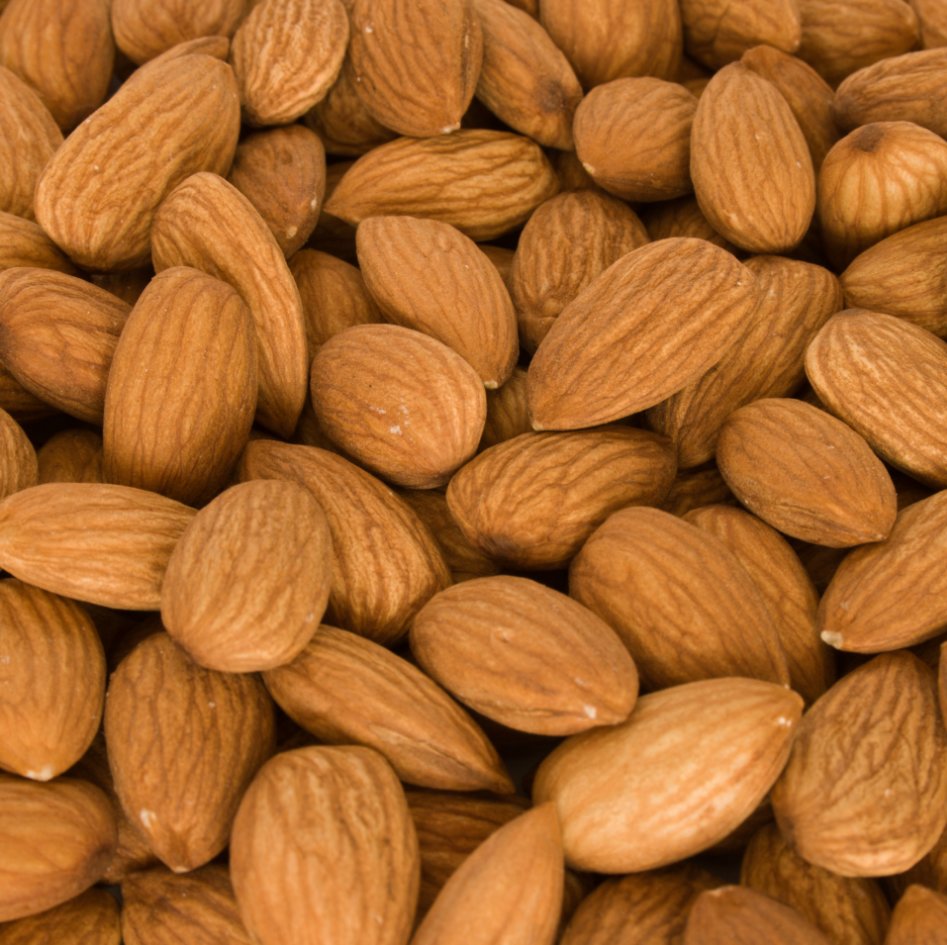 The common almond is divided into two subspecies: almonds are wild (bitter) and almonds are sweet.
The common almond is divided into two subspecies: almonds are wild (bitter) and almonds are sweet.
Wild almonds contain hydrocyanic acid in the nuclei, so it is grown exclusively for medicinal purposes.
For eating, sweet almonds are grown.
There are varieties of almond, growing with a bush, there are varieties that grow with a tree. This species grows to six meters in height.
Bark on the trunk of almond brown hue, on branches with a gray outburst, in young stems - reddish. Leaves are not wide, with a long petiole and sharp tip, along the edge of the leaf plate - teeth. The shape of the leaves is an elongated oval.
Almond, depending on the variety, blooms from February to April, which is interesting - before the leaves are blooming. He has large white or light pink flowers, growing alone.
The fruits of the plant ripen in June - July. Fruits-drupes are covered with pile gray or green, the seed - the nut is in a thin shell. The shape of the bone is similar to a nail: on the one hand it is rounded, on the other it is smoothly pointed. Nuts are large, up to 2 cm long.
Did you know? In ancient Egypt, the healing properties of almonds were used to maintain the body of pregnant women. Fruits of the plant were served on the table of important dignitaries and pharaohs.
Almond low (steppe, bean)
 Almond low beard grows up to one and a half meters tall. This species is a deciduous shrub. He has a dense crown, forming a ball, with dense straight branches. The bark is gray with a reddish tinge. The leaves are dense, fleshy, oblong, lanceolate. The length of the leaves is up to 6 cm, the color is dark green on the upper plate and lighter on the lower plate.
Almond low beard grows up to one and a half meters tall. This species is a deciduous shrub. He has a dense crown, forming a ball, with dense straight branches. The bark is gray with a reddish tinge. The leaves are dense, fleshy, oblong, lanceolate. The length of the leaves is up to 6 cm, the color is dark green on the upper plate and lighter on the lower plate.
The beaver has a lush but short flowering. Blossoms almonds low in late March - early April. Small buds of a burgundy shade are located on sitting short shoots. Blossoming flowers in diameter up to 3 cm, full of pink color with bitterish aroma.
This kind of almond blossoms simultaneously with the leaves. Flowering lasts less than two weeks. Fruit-drupe in the form of eggs up to 2 cm long, flattened and pubescent. Fruit ripening occurs in July. Seed is dense, with longitudinal stripes, edible. This species is represented by varieties with white and pink flowers.
Shrub almonds - this is an almond blooming in a snow-white color. There are many flowers on the bushes, it is literally strewn with them. The diameter of the flowers is about 10 mm. "White sail" for a long time can do without watering: this southern plant is resistant to drought. 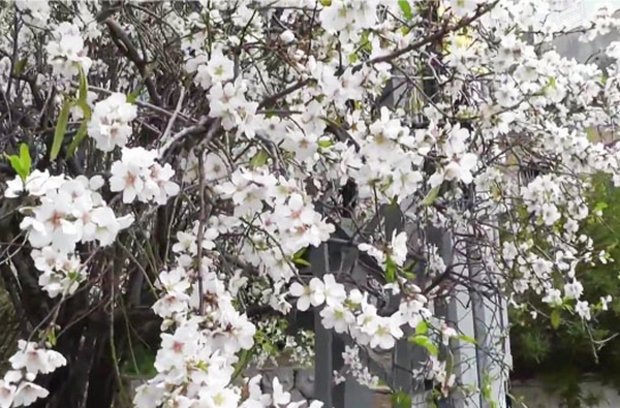
Blooms in early April, covering the crown with bright pink flowers up to 2.5 cm in diameter. Fruit ripening begins in early autumn, near the end of September. Nuts are large - up to 6 cm in length, a seed with a delicate aroma and a pleasant sweetish taste. 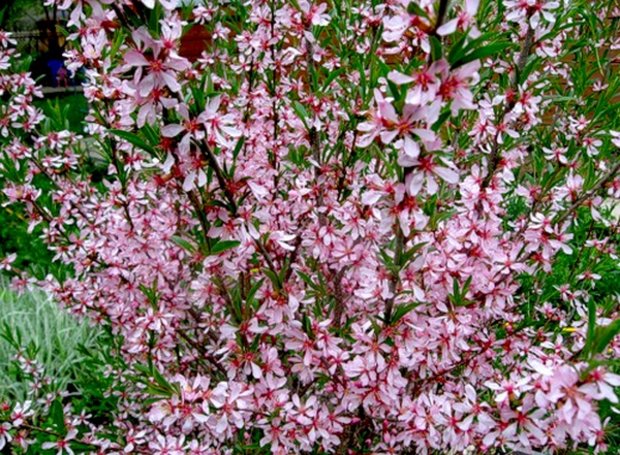
The almond bush likes to grow in open areas, illuminated most of the day by direct sunlight. Not bad feels in the penumbra. The plant is afraid of drafts and sudden temperature changes. Blossoming "Dream" with delicate pink flowers just over 2 cm in diameter. 
- this is an early variety of low bean, it blooms almost a week before other varieties. Flowering plants are terry, small, to a centimeter in diameter, pink flowers. This variety is often used in landscape design, also it is loved by cosmetologists. 
Important! Nuts of bitter almonds because of their toxicity can lead to death of a person. A child of up to twelve years old enough to eat ten seeds, and an adult - about fifty.
The variety will last longer in the shade, and more luxuriantly in full sunlight. This variety has large, to 2.5 cm in diameter, bright pink flowers. 
- a species with a limited distribution area, it grows on the territory of the Caucasus. Growing bush, similar to external data on the bean. The species has a small number of branches, but many root processes. 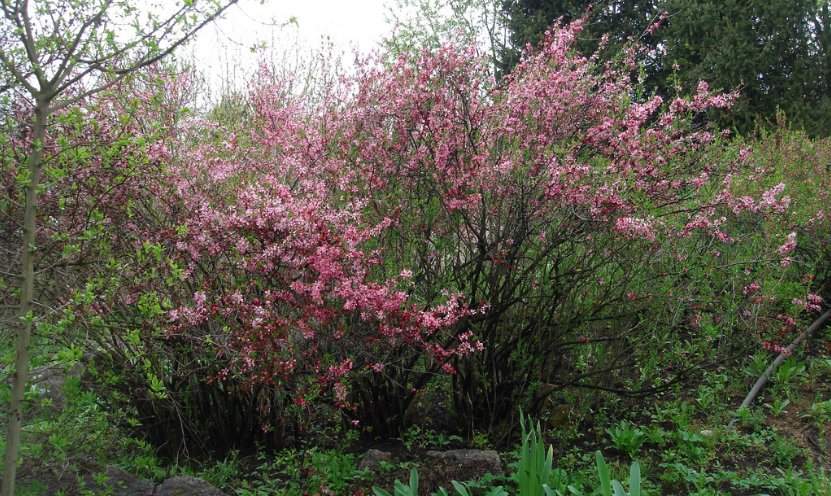
The leaves, depending on the variety, can be broad and oblong in shape, up to 8 cm in length. Large flowers, mostly pink, blossom in May. The fruit variety is not plentiful, the fruits are pubescent, green with a gray outflow.
This almond is frost-resistant, drought-resistant and undemanding to the ground. These qualities make the plant valuable in terms of breeding. In addition to the above characteristics, the plant is resistant to diseases and pests. With good and proper care retains the decorative characteristics of up to thirty years.
Interesting! During flowering almonds fascinate with its exquisite defenseless beauty. His color was sung by poets, writers, artists. The blossoming view of almonds was struck by Garsevan Cholokashvili, Frida Polak, Konstantin Paustovsky. Flowering almond branches inspired Vincent Van Gogh to paint a painting with the same name.
Distribution area almond Ledebour - Altai. It grows in the foothills, meadows and steppes. The plant prefers moderate moistening of the soil, it is pollinated well by insects. 
Ledebour's Almond is frost-resistant, light-loving and abundantly blooming. In nature, almonds of this species form whole thickets of bushes with large dark green leaves.
The plant blooms before other species with pink flowers, flowering lasts up to three weeks. Almond Ledebour fruits from the age of ten. The most popular variety - Fire Hill with reddish flowers up to 3 cm in diameter.
- a low shrub, no higher than a meter. The distribution area is Central Asia. More often upright branches form a dense crown in the form of a ball. The bark of the branches is colored gray with a brownish tint or a yellowish tinge. 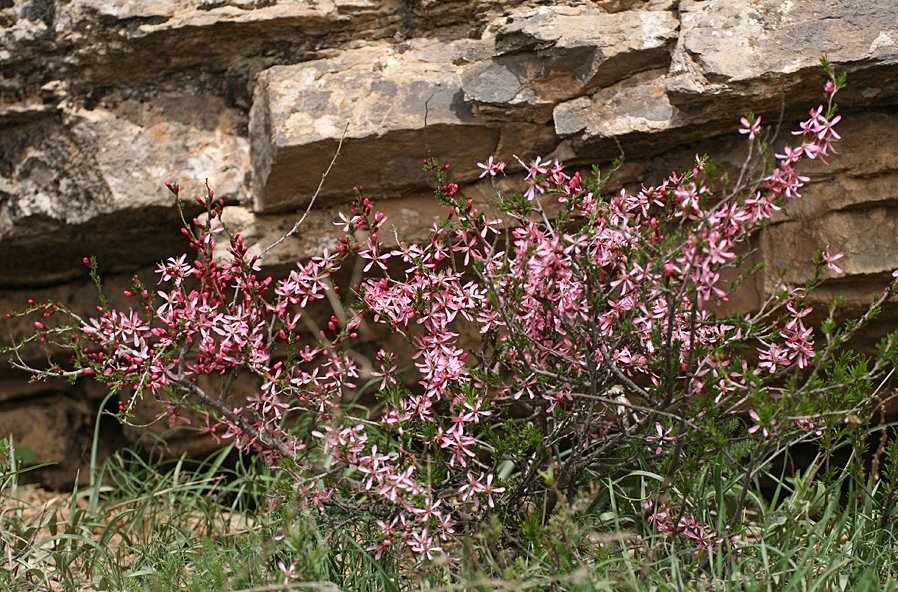
Leaves with smooth notches along the edge, a lanceolate shape and a sharp tip. Flowering begins at the age of three, in the month of May. Blossoms almonds in pink, flowering lasts two weeks. At the age of five, almonds begin to bear fruit. Fruits are small, pubescent, orange or yellow-brown in color.
Almond trilobate
 Almonds three-bladed Is a tall shrub with a broad and spreading crown.
Almonds three-bladed Is a tall shrub with a broad and spreading crown.
The name of the almond went from the shape of the leaves, forming three blade-plates.
The leaves are covered with pile on the underside of the leaf plate, along the edge are fringed with denticles. Flowers of different shades and diameters are located on the shoot in pairs.
There are two decorative subspecies:
- "Captivity" - with terry flowers, large - up to 4 cm in diameter. Rose petals bloom after the leaves. The bush grows up to 3 m in height;
- - up to 3.5 m tall, lushly flowering. Pink flowers blossom before the appearance of leaves, large flowers, terry.
"Svitlana"
"Svitlana" - a variety bred by Ukrainian breeders. The variety is resistant to frost, unpretentious. Flowers at the "Svitlana" very pale shade. Abundant bloom even with minimal care.
- Almonds with terry large flowers up to 3.5 cm in diameter. The petals appear to be twisted. The variety is frost-resistant, it does not die at -25 ° С. Threat can be represented only by prolonged thaws and lack of snow cover. In this case, the kidneys of almonds die.

"In memory of Mahmet"
"In memory of Mahmet" - the variety blooms before the leaves are blooming. He has double flowers creamy-pink shade. Flowering lasts about two weeks. In the landscape, bulbous plants are most often planted next to it.
"Chinese"
"Chinese" - a variety with pale pink flowers, not terry. "Chinese woman" feels great in urban parks, gardens and alleys.
Attention! Three-lobed almonds are prone to "moniliya" (fungus), this disease affects young weak shoots. For prevention, annual pruning is carried out after the flowering period.
- Three-bladed almond almonds. Large flowers are pale pink at the end of flowering, change color to cream. The plant feels best in open areas among coniferous ornamental bushes and trees. 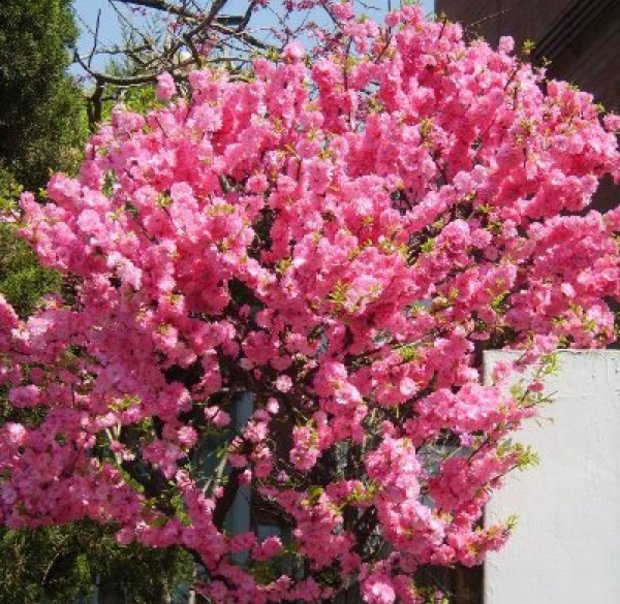
"Ruslana"
"Ruslana" - a hybrid variety that changes color. At the beginning of flowering the petals of cream color turn white.
Almonds are a popular and useful plant. Its fruits are used not only in medicine and cosmetology, almond nuts help with the passage of therapeutic or weight-reducing diets.
Almond is also popular in cooking, it is based on many delicious, airy cakes, cakes, mousses, creams and other desserts. Widespread use of almonds and in the manufacture of alcohol. Bushes blossoming almonds adorn park areas, gardens and avenues.
Was this article useful?
Well no


